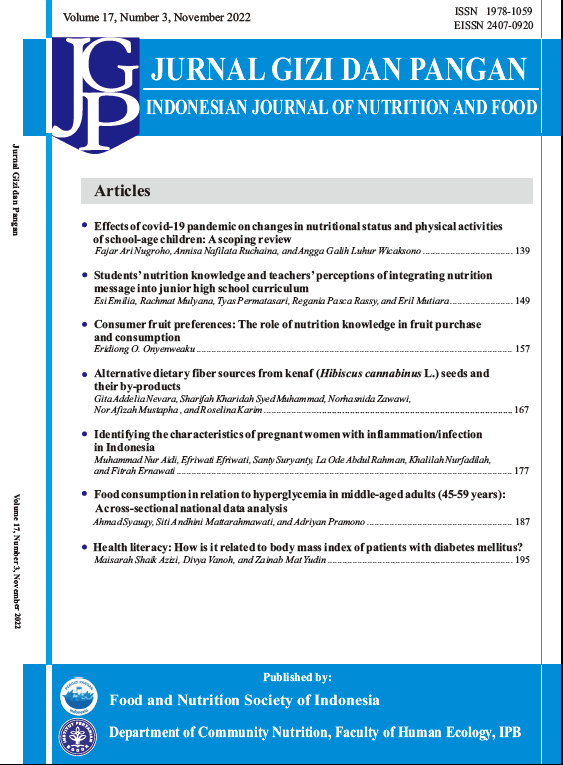Consumer Fruit Preferences: The Role of Nutrition Knowledge in Fruit Purchase and Consumption
Abstract
This study aims at ascertaining consumer fruit preferences and role of nutrition knowledge in consumers’ attitudes and practice as it concerns fruit consumption. An online questionnaire was used for this cross-sectional survey carried out in South Africa. The questionnaire link was circulated in the nine provinces for 4weeks; information gathered include sociodemographic data, respondents’ nutrition knowledge, and consumer fruit preferences alongside their fruit consumption patterns. Based on their responses, Nutrition Knowledge Scores (NKS) were calculated. Pearson correlation test was used to check for any relationship between the NKS, some sociodemographic factors and fruit preferences/consumption (significance was accepted at p<0.05). Three provinces; Gauteng, North West and KwaZulu-Natal accounted for over 70% of the 517 responses received. Almost half of the surveyed population had high NKS (45.5%) while 27.3% scored moderately and another 27.3% low. The most preferred fruits were oranges, bananas, and mangoes; others such as plums and berries were also preferred but not as consumed as the others due to their seasonal nature. The results show a positive relationship (p<0.001) between nutrition knowledge and fruit consumption frequency and healthy dietary patterns, but only significant but weak correlation between respondents’ nutrition knowledge and priority factors that affect their dietary product choices and purchases. Nutrition education is vital in enhancing awareness that will in turn yield positive results in fruit consumption and health outcomes.
References
Barreiro-Hurle J, Gracia A, De-Magistris T. 2010. "Does nutrition information on food products lead to healthier food choices?." Food Policy 35(3):221‒229. https://doi.org/10.1016/j.foodpol.2009.12.006
Bazzano LA, Li TY, Joshipura KJ, Hu FB. 2008. Intake of fruit, vegetables, and fruit juices and risk of diabetes in women. Diabetes Care 31(7):1311‒1317. https://doi.org/10.2337/dc08-0080
Brinkley JK, Golub A. 2011. Consumer demand for nutrition versus taste in four major food categories. Agric Econs 42:(1) 65‒74. https://doi.org/10.1111/j.1574-0862.2010.00471.x
Chivenge P, Mabhaudhi T, Modi AT, Mafongoya P. 2015. The potential role of neglected and underutilized crop species as future crops under water scarce conditions in Sub-Saharan Africa. Int J Environ Health Res 12(6):5685‒5711. https://doi.org/10.3390/ijerph120605685
Erinosho TO, Moser RP, Oh AY, Nebeling LC, Yaroch AL. 2012. Awareness of the fruits and veggies-more matters campaign, knowledge of the fruit and vegetable recommendation, and fruit and vegetable intake of adults in the 2007 food attitudes and behaviors (FAB) survey. Appetite 59(1):155‒160. https://doi.org/10.1016/j.appet.2012.04.010
Frison E, Smith If, Cherfas J, Eyzaguirre P, Johns T. 2005. Using biodiversity for food, dietary diversity, better nutrition and health. South African J Clin Nutr. 18(2):112‒114. https://doi.org/10.1080/16070658.2005.11734050
Garber Jr LL, Hyatt EM, Starr Jr RG. 2003. Measuring consumer response to food products. Food Qual & Pref 14(1):3‒15. https://doi.org/10.1016/S0950-3293(02)00030-7
Jansen A, Stoltz E. 2008. Is the Zero-Rating of Basic Foodstuffs in South Africa Well Targeted? Pretoria (SA): National Treasury South Africa.
Kirk RE. 2008. Statistics: An introduction. 5th ed. Belmont (USA): Thomson Wadsworth.
Kish L. 2017. Survey Sampling. First Edition Published 1965. New York (USA): John Wiley & Sons, Wiley Classics
Kucich DA, Wicht MM. 2016. South African indigenous fruits-Underutilized resource for boosting daily antioxidant intake among local indigent populations? South African J Clin Nutr 29(4):150‒156. https://doi.org/10.1080/16070658.2016.1219470
Kumar P, Kumar M, Bedi O, Gupta M, Kumar S, Jaiswal G, Rahi V, Yedke NG, Bijalwan A, Sharma S, Jamwal S. 2021. Role of vitamins and minerals as immunity boosters in covid-19. Inflammopharmacology 29(4):1001‒1016. https://doi.org/10.1007/s10787-021-00826-7
Layade AA, Adeoye IB. 2014. Fruit and vegetable consumption among students of tertiary institutions in Oyo state. Russ J Agric & Socio-Econ Sci 30(6):3‒8. https://doi.org/10.18551/rjoas.2014-06.01
Lin BH, Yen ST. 2008. Consumer knowledge, food label use and grain consumption in the US. Applied Econs 40(4):437‒448. https://doi.org/10.1080/00036840600690298
Lindberg BG, Tang X, Dantoft W, Gohel P, Seyedoleslami ES, Lindvall JM, Engström Y. 2018. Nubbin isoform antagonism governs drosophila intestinal immune homeostasis. Plos Pathog 14(3):e1006936. https://doi.org/10.1371/journal.ppat.1006936
Muchiri JW, Gericke GJ, Rheeder P. 2016. Effect of a nutrition education programme on clinical status and dietary behaviors of adults with type 2 diabetes in a resource-limited setting in South Africa: A randomized controlled trial. Public Health Nutr 19(1):142‒155. https://doi.org/10.1017/S1368980015000956
Nyawo T, Kesa H, Onyenweaku E. 2020. Food safety and hygiene: Knowledge, attitude and practices among food handlers. Afr J Hosp Tourism & Leisure 10(2):547‒558. https://doi.org/10.46222/ajhtl.19770720.117
Obayelu OA, Ibe RB, Adegbite O, Oladimeji A. 2019. Demand for Selected Fruits among students of a tertiary Institution in Southwest Nigeria. Intl J Fruit Sci 19(1):45‒56. https://doi.org/10.1080/15538362.2018.1533911
Onyenweaku EO, Ene-Obong HN, Oko GE, Williams IO. 2019. Contribution of eggs and other cholesterol-containing foods to total dietary cholesterol intake, and their influence on serum lipid profile of adults in Calabar, Nigeria. Eur J Nutr 9:329‒340. https://doi.org/10.9734/ejnfs/2019/v9i430080
Shimokawa S. 2010. Asymmetric intra-household allocation of calories in China. American J Agric Econs 92(3):873‒888. https://doi.org/10.1093/ajae/aap043
Shimokawa S. 2013. When does dietary knowledge matter to obesity and overweight prevention? Food Policy 38:35‒46. https://doi.org/10.1016/j.foodpol.2012.09.001
Temple NJ, Steyn NP, Fourie J, De Villiers A. 2011. Price and availability of healthy food: A study in rural South Africa. Nutrients 27(1):55‒58. https://doi.org/10.1016/j.nut.2009.12.004
Turker T, Kocak N, Aydin I, Istanbullouglu H, Yildiran N, Turk YZ, Kilic S. 2013. Determination of knowledge, attitude, behavior about genetically modified organisms in nursing school students. Gülhane Tip Dergisi 55(4):297–304.
Variyam JN. 2008. Do nutrition labels improve dietary outcomes? Health Econs 17(6):695‒708. https://doi.org/10.1002/hec.1287
[WHO] World Health Organization. 2003. Diet, Nutrition and The Prevention of Chronic Diseases: Report of a Joint FAO/WHO Expert Consultation. WHO Technical Report Series No. 916. Geneva (CH): World Health Organization.
[WHO] World Health Organization. 2020. Factsheet on healthy diet. https://www.who.int/news-room/fact-sheets/detail/healthy-diet [Accessed June 16th 2022].
Wardle J, Parmenter K, Waller J. 2000. Nutrition knowledge and food intake. Appetite 34(3):269‒275. https://doi.org/10.1006/appe.1999.0311
Webbink D, Martin NG, Visscher PM. 2010. Does education reduce the probability of being overweight? J Health Econs 29(1):29‒38. https://doi.org/10.1016/j.jhealeco.2009.11.013
Wunderlich S, Gatto K. 2016. Consumers' food choices and the role of perceived environmental impact. Intl J Sust Dev & Plann 163:989‒995. https://doi.org/10.2495/SDP-V11-N6-989-995/017
Authors

This work is licensed under a Creative Commons Attribution-ShareAlike 4.0 International License.
The copyright of manuscripts of the article shall be assigned/transferred to Jurnal Gizi dan Pangan (Indonesian Journal of Nutrition and Food)






